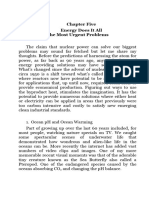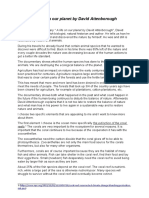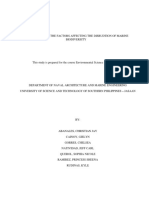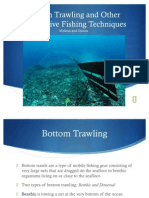Lethal Seas
Lethal Seas
Uploaded by
Michael ShiCopyright:
Available Formats
Lethal Seas
Lethal Seas
Uploaded by
Michael ShiOriginal Description:
Original Title
Copyright
Available Formats
Share this document
Did you find this document useful?
Is this content inappropriate?
Copyright:
Available Formats
Lethal Seas
Lethal Seas
Uploaded by
Michael ShiCopyright:
Available Formats
Name: ________________________ September 11, 2019
Physical Science
Lethal Seas - NOVA
1. How do oyster larvae that live in acidic water differ from those that live in normal water?
Oysters larvae that live in acidic water are deformed, pink and usually died.
2. How can oyster farmers “fix” this problem?
Oysters farmers use a water softener to lower the PH.
3. The acidity of the oceans is increasing by 5% every decade.
4. About a quarter of the CO2 released by humans is absorbed into the oceans.
5. About 30 million metric tons of CO2 is dissolved into the oceans every day.
6. In the ocean, the CO2 combines with water to produce carbonic acid.
7. Coral reefs represent 1% of the ocean but provide homes to 25% of marine species.
8. What is unusual about the “bubbling” reefs near Papua, New Guinea?
The bubbles are made of pure carbon dioxide. Commented [1]: What effect does this have?
9. Why is it important to use DNA to study the effects of the decrease in pH on the diversity of
species on coral reefs?
It is important to use DNA to study the effect of the decrease in PH to find what and how many
types of creatures there are.
Name: ________________________ September 11, 2019
Physical Science
10. What are pteropods? Why are they essential for marine ecosystems?
Pteropods are tiny snails that are at the bottom of the food chain and they provide foods and
support the whole food chain.
11. What was the probable cause of the Permian Extinction?
Massive volcanic eruptions and carbon dioxide levels increased too quickly which caused the
acidity to rise.
12. How does a decrease in the pH of water affect fish reactions to predators? Why does this
happen?
The fish that grew in lower PH don’t run away from predators and are more adventurous Commented [2]: pH
because of the lower PH affects their brain and their cognitive ability.
13. Why are the upwellings on the California coast a good place to study adaptation to climate
change?
There is a seasonal change of PH because of the wind blowing up CO2 rich water and you
could study their adaptions to the change.
Name: ________________________ September 11, 2019
Physical Science
14. Who is on frame 41:53 of this video?
Mrs. Kelly's daughter
15. What effect does lowering pH of water have on the recruitment of coral polyps on reefs?
The lowering pH causes less coral recruits which means the reefs cant reproduce, making it
die out.
16. Why do corals all spawn at the same time?
The coral all release on the lunar cycle, so the eggs are more likely to fertilize and there is also
more protection.
17. How much are the people of Papua, New Guinea responsible for climate change? How will
they be affected by its consequences?
The people of New Guinea are not really responsible for climate change because they don't
have many carbon-emitting machines like factories or cars. They will be affected a lot because
their food supply will disappear and their coral reefs will also disappear.
You might also like
- A Trip To The Beach Case StudyDocument3 pagesA Trip To The Beach Case StudynadhraNo ratings yet
- Ocean Acidification PPDocument17 pagesOcean Acidification PParpita laxmanNo ratings yet
- Ice CoresDocument2 pagesIce Coresapi-334125776No ratings yet
- Bacias Sedimentares Da Margem Continental Brasileira-Webster Ueipass Mohriak-CPRMDocument79 pagesBacias Sedimentares Da Margem Continental Brasileira-Webster Ueipass Mohriak-CPRMrottoschmidt100% (2)
- Coral Bleaching ScripDocument6 pagesCoral Bleaching Scriplailatur rohmaniyahNo ratings yet
- Unit 2 LabDocument3 pagesUnit 2 LabKyle CochraneNo ratings yet
- Table of ContentDocument21 pagesTable of ContentJamieNo ratings yet
- Environmental Science Presentation Semester-2 (2020-21) Ramjas College, Delhi University Department of MathematicsDocument20 pagesEnvironmental Science Presentation Semester-2 (2020-21) Ramjas College, Delhi University Department of MathematicsmylahNo ratings yet
- Ocean Acidification: Jumanah Amoudi College Preparation Program English 036, 3002 March 3, 2022Document10 pagesOcean Acidification: Jumanah Amoudi College Preparation Program English 036, 3002 March 3, 2022chum chumNo ratings yet
- GBRDocument8 pagesGBRapi-650131778No ratings yet
- Ocean AcidificationDocument2 pagesOcean AcidificationRishiNo ratings yet
- Ocean Acidification Pacific (2)Document2 pagesOcean Acidification Pacific (2)Henrique Pires dos SantosNo ratings yet
- Ocean Acidification - Ashwin ShajithDocument18 pagesOcean Acidification - Ashwin ShajithAshwin ShajithNo ratings yet
- ResearchDocument52 pagesResearchhisyam_muhd8No ratings yet
- OA20Facts NovDocument2 pagesOA20Facts NovDongsipoi HuynhNo ratings yet
- CH 5Document37 pagesCH 5Rick MalteseNo ratings yet
- ROJAN ScienceDocument6 pagesROJAN ScienceRica CalaguasNo ratings yet
- For Thousands of YearsDocument3 pagesFor Thousands of YearsMdpn. SalvadorNo ratings yet
- Extra 1Document5 pagesExtra 1Atul SinghNo ratings yet
- Aquatic EcologyDocument21 pagesAquatic EcologyEwa PateckaNo ratings yet
- Ocean Acidification Case StudyDocument2 pagesOcean Acidification Case Studynicole yuNo ratings yet
- Abstract For IPESF 2024Document10 pagesAbstract For IPESF 2024piyal64No ratings yet
- Biological Productivity NotesDocument2 pagesBiological Productivity Notesavi97No ratings yet
- Writing 2 WP 2 1Document6 pagesWriting 2 WP 2 1api-553728333No ratings yet
- A Call For Change - Research PaperDocument7 pagesA Call For Change - Research Paperapi-242446247No ratings yet
- Reading Exercises Meeting 5Document4 pagesReading Exercises Meeting 5indramulyawan04No ratings yet
- 10.ans To PE 1 - 6 PG 51-57,58Document8 pages10.ans To PE 1 - 6 PG 51-57,58lisahane20No ratings yet
- What We Know, What We Need To Know and What We Can Do: Impact of Ocean Acidification On PlanktonDocument49 pagesWhat We Know, What We Need To Know and What We Can Do: Impact of Ocean Acidification On PlanktonhameedhaaNo ratings yet
- Ian Ridge - Research Paper Overfishing Impacts On Coral Reefs and Marine LifeDocument6 pagesIan Ridge - Research Paper Overfishing Impacts On Coral Reefs and Marine Lifeapi-544192415No ratings yet
- The Utilization of Powdered Janitor Fish Bones From Marikina River As Soil Acidity Reducing AgentDocument26 pagesThe Utilization of Powdered Janitor Fish Bones From Marikina River As Soil Acidity Reducing AgentDavid YapNo ratings yet
- Chapter 1 - IntroductionDocument19 pagesChapter 1 - IntroductionEdjey Luis F. MatinongNo ratings yet
- Essay AttenboroughDocument2 pagesEssay AttenboroughElif KucunNo ratings yet
- Thesis Related To Water PollutionDocument8 pagesThesis Related To Water PollutionBrandi Gonzales100% (2)
- Environment ArticelDocument3 pagesEnvironment ArticelNazliNo ratings yet
- Role of Water and Soil Parameters in Pond ProductivityDocument23 pagesRole of Water and Soil Parameters in Pond Productivityapi-3803371100% (5)
- Eutrophication LabDocument4 pagesEutrophication LabSamanthaKhallanNo ratings yet
- Coral Reefs, Nature Works For Nature Work PLA, The Sound of DolphinDocument9 pagesCoral Reefs, Nature Works For Nature Work PLA, The Sound of DolphinIelts ReadingsNo ratings yet
- Local Media8122030208164119590Document21 pagesLocal Media8122030208164119590Raida AdimNo ratings yet
- CoralDocument2 pagesCoralKenny GirmanNo ratings yet
- Jake Sacksteder - Final PaperDocument3 pagesJake Sacksteder - Final Paperapi-529504575No ratings yet
- 7 Envi PrinciplesDocument9 pages7 Envi PrinciplesBrian JosephNo ratings yet
- PDF - Marine Bio Semester Two Review SheetDocument2 pagesPDF - Marine Bio Semester Two Review Sheetapi-205313794No ratings yet
- Research Paper About Marine LifeDocument8 pagesResearch Paper About Marine Lifeafnhcikzzncojo100% (1)
- STS Ganjil English 11Document4 pagesSTS Ganjil English 11Moh Syaeful BahriNo ratings yet
- Ocean AcidificationDocument6 pagesOcean AcidificationKFYBsc IT 052 Nihar NegandhiNo ratings yet
- Chapter 2 Review of The Related LiteratureDocument12 pagesChapter 2 Review of The Related Literaturewindow painNo ratings yet
- PollutionDocument6 pagesPollutionMehvish ChohanNo ratings yet
- Impacts of AcidificationDocument4 pagesImpacts of AcidificationJeanieOrateNo ratings yet
- Week 3 Progress CheckDocument2 pagesWeek 3 Progress CheckJoshua Ray CalagoNo ratings yet
- Final Case StudyDocument8 pagesFinal Case StudyChristian Jay AbanalesNo ratings yet
- 01 - Soil and Water Quality ConsiderationsDocument30 pages01 - Soil and Water Quality ConsiderationsdeltakoNo ratings yet
- Marine Life Habitat ConservationDocument3 pagesMarine Life Habitat ConservationJerome ReyesNo ratings yet
- Ulo 4c in A Nutshell - HydroDocument1 pageUlo 4c in A Nutshell - HydroJohn LloydNo ratings yet
- Ocean AcidificationDocument6 pagesOcean AcidificationcarlodolciNo ratings yet
- Resolving The Water Pollution Crisis in The Philippines - The ImplDocument15 pagesResolving The Water Pollution Crisis in The Philippines - The ImplMary Jean PaclibarNo ratings yet
- Algae Economic ImportanceDocument11 pagesAlgae Economic ImportancemanawNo ratings yet
- Jumble Words AcidDocument24 pagesJumble Words AcidFranchesca Mekila TuradoNo ratings yet
- Anuvrinda SharmaDocument9 pagesAnuvrinda SharmaSwattick ChakrabortyNo ratings yet
- EARTH SCIENCE Q1 WK 5.a Human Activities On Water For Student 1Document14 pagesEARTH SCIENCE Q1 WK 5.a Human Activities On Water For Student 1KING OF GAMER 2.0No ratings yet
- The Tragedy of the Commodity: Oceans, Fisheries, and AquacultureFrom EverandThe Tragedy of the Commodity: Oceans, Fisheries, and AquacultureNo ratings yet
- The Seaweed Revolution: How Seaweed Has Shaped Our Past and Can Save Our FutureFrom EverandThe Seaweed Revolution: How Seaweed Has Shaped Our Past and Can Save Our FutureNo ratings yet
- Discovering Flatfish : Unique Biology, Behavior, and Ecological RolesFrom EverandDiscovering Flatfish : Unique Biology, Behavior, and Ecological RolesNo ratings yet
- Classification of RiversDocument3 pagesClassification of RiversJohn WesleyNo ratings yet
- AntifoulingDocument3 pagesAntifoulingJohn MithuNo ratings yet
- Hydrosphere PDFDocument10 pagesHydrosphere PDFharry joeNo ratings yet
- Essay Blue WhaleDocument2 pagesEssay Blue WhaleRăzvan ParaschivNo ratings yet
- 03 Texto PrincipalDocument208 pages03 Texto Principaljamegar9920No ratings yet
- Temperature Salinity and Water Density Lab-1Document4 pagesTemperature Salinity and Water Density Lab-1OSCAR SUY-PEREZNo ratings yet
- Plastic Pollution On Marine Life and Environment 2Document9 pagesPlastic Pollution On Marine Life and Environment 2api-429920876No ratings yet
- Bottom TrawlingDocument13 pagesBottom TrawlingMelissa Wartman100% (1)
- Liu053 The Dead SeaDocument3 pagesLiu053 The Dead SeaD. Brookes Language schoolNo ratings yet
- Global WarmingDocument22 pagesGlobal WarmingKetan AgrawalNo ratings yet
- Meeting 3, Packet #1Document267 pagesMeeting 3, Packet #1National Commission on the BP Deepwater Horizon Oil Spill and Offshore DrillingNo ratings yet
- Soal LM B.ingg Xi Genap 2016 - HJ NenengDocument6 pagesSoal LM B.ingg Xi Genap 2016 - HJ Nenengdiky_defaNo ratings yet
- Miocene OceanDocument1 pageMiocene OceanRio Cendrajaya100% (1)
- C4 ClimateAndClimateChangeDocument72 pagesC4 ClimateAndClimateChangeKajemm InfoNo ratings yet
- A Plastic Ocean Is A Film To MakeDocument1 pageA Plastic Ocean Is A Film To MakePonleu KinNo ratings yet
- Marine Water Pollution Project GeoDocument9 pagesMarine Water Pollution Project GeoRanjana MallavaramNo ratings yet
- Project 24 - Biodiversity - MangroovesDocument7 pagesProject 24 - Biodiversity - MangroovesUjjval Nagota100% (2)
- Blue Economy Versus Ocean Economy (Download PDF) : ExamraceDocument4 pagesBlue Economy Versus Ocean Economy (Download PDF) : ExamraceBholendra SinghNo ratings yet
- On CycolneDocument37 pagesOn CycolneMoshin Khan100% (1)
- ĐỀ SỐ 9 - KEYDocument5 pagesĐỀ SỐ 9 - KEYAnh MaiNo ratings yet
- Importance of Oceans: United Nations Convention On The Law of The Seas (UNCLOS)Document3 pagesImportance of Oceans: United Nations Convention On The Law of The Seas (UNCLOS)Ara HaanNo ratings yet
- The Bounty of The SeaDocument3 pagesThe Bounty of The SeaWest Nation100% (2)
- CCIA 2015 NRM TR Executive SummaryDocument5 pagesCCIA 2015 NRM TR Executive SummaryahmedbhattiNo ratings yet
- 9 Methods For ODocument6 pages9 Methods For OErmiasNo ratings yet
- Tropical Oceans: Word SearchDocument2 pagesTropical Oceans: Word SearchAgrobacterium TumefaciensNo ratings yet
- Aquatic Life ZonesDocument10 pagesAquatic Life ZonesJan Marie100% (1)
- Engine Circular No. 5/ 2012: NO: ENG/PSC/1194 Dated: 7 November, 2012Document2 pagesEngine Circular No. 5/ 2012: NO: ENG/PSC/1194 Dated: 7 November, 2012afreddy1958No ratings yet
- UNEP - France - Adinda Putri MahindraDocument2 pagesUNEP - France - Adinda Putri MahindraAdhilla SalsabilaNo ratings yet

























































































